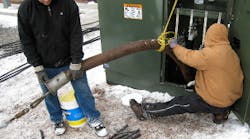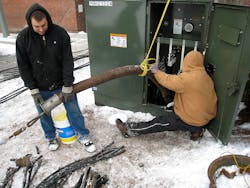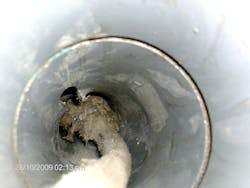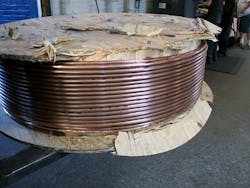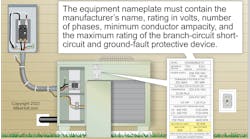You’d think there’s not much more to say about cable pulling that hasn’t already been said in the past. Many books and articles have been published on the subject over the years, and not much has changed along the way. Ask anyone with at least a few years of experience under his belt, and you’ll likely hear a story or two of a difficult cable pull — where the tension reached critical limits, where a creative pull arrangement using unorthodox methods was employed, or where someone used a specific instrument that made all the difference.
What many people don’t realize is that the key to a successful pull hinges on the steps you take before you even begin to feed the cable into the puller. Assuming a quality cable product has been procured and delivered safely to your job site, consider the following factors before you start the pull.
Temperature
Various conductor insulations have different operating temperature ranges for safe installation and use. Electrical construction knows no season — as many cable pulls are performed in cold climates as in warm. A common error in judgment is to pull cable when it has been stored in a cold environment (Photo 1).In this situation, the insulation has what is best described as a brittle condition like most any thermoplastic or rubber material. This condition is conducive to cracking or splitting, even when under minimal pulling tension or bend radii. Remember, damaged insulation is no different than no insulation at all in the long run.
Moisture
The presence of moisture more readily affects some cables than others. Moisture is just as important in the vapor state of matter as it is in liquid. Shielded cables, whether coaxial cable or medium-voltage power cable, can absorb moisture over time. This moisture level can significantly affect the insulation and capacitive characteristics of the cable. Capillary action negatively affects all types of electrical cable. No matter what the cable type is, it’s best to seal the cable ends with an approved sealing method. Rubber and plastic insulation tapes suffice in many cases, but some manufacturers may require cable end sealing kits, which are typically a one-time application heat shrink device placed on the cable ends to protect them until the field termination process begins.
Calculations
There are many programs in the industry using common formulas and friction constants for the calculation of cable pulling tensions. Gravity, length of raceway, type of raceway, total degrees of bend, individual bend radii, and friction coefficients are but a few formula variables. Electricians and other electrical contractor personnel are essential in planning and performing a productive cable installation. Although project design specifications typically state the maximum number of bends allowed in raceways — and recommend using only approved pulling lubricants — the raceway installation and cable pulling tasks are the “means and methods” of a project, defined by applicable building codes and manufacturer installation requirements. It’s your responsibility to review these specs prior to performing any work.
Raceways
Type and size of raceway are significant factors in making a cable pull installation productive. The difference in cost between any two sequential conduit sizes is negligible compared to the lost time you might incur on a delayed pull. The cable could easily be damaged during installation if the raceway is inadequately sized. Therefore, it’s always best to upsize a raceway whenever possible.
Few raceways are free of debris. Therefore, it’s your responsibility to know the methods and tools available to clean or clear a raceway. The most common method of clearing a raceway is to use high pressure air or an approved clearing device (e.g., Mandrel) and rope. Occasionally, you may identify obstacles such as solid obstructions (sand, dirt, or concrete infiltration), raceway deformation or compression, or animal infestations.
Another factor to consider is the entrance and exit bends and fittings. It’s beneficial to use a steel-type material at these locations. PVC often experiences rope or cable burns over long-distance cable pulls and can cause difficulty and delay during the cable installation process (Photo 2).Conductor
Conductor size and type can affect the type of raceway allowed or preferred for a cable installation. For example, some rubber-type insulations are not as easily installed in a PVC raceway. Approved lubrication will help in the cable pull, but, over time, the lubrication loses some or all of its lubricating characteristics. This will make removal of the same rubber-type insulation difficult and sometimes impossible, depending on the conductor operating conditions. Cable removal is just as applicable when it comes to removing faulted cable or abandoned cable due to renovation projects. Some cable pulling tension calculations will include variables such as insulation type, conductor type, and strand type.
There are all types and sizes of rope that are used in the construction process. Don’t make the mistake of thinking you can just pick up a spare one lying around and use it for your next pull. You must use ropes specifically designed for use in cable pulling. The size of a rope will have a corresponding capacity for allowable pulling tension (click here to see Table) Using a ¼-in. rope to install four 600kcmil conductors in a 400-ft raceway is not practical. Even when a rope is applied correctly to a calculated pulling tension, the condition of the rope is of utmost importance. The rope must be clean, dry, not kinked or knotted, free of nicks and frays, and stored in a manner that minimizes or eliminates these conditions.
Cable spools and reels
Cable spools and reels come in a variety of sizes and material types. Tin or plastic spools are often used for smaller conductors. Wood reels are typically used for larger conductors. No matter what type of material the reel or spool is made of, there are work practices you must follow to avoid damaging the cable.
Spools and reels must be free from bent or sharp edges, cracked or broken aprons, and dirt and debris (Photo 3).Rough handling can easily damage a small spool. Dropping a small spool on a dirt-covered construction site will only make for a potentially difficult cable pull, as dirt and mud can damage the insulation as it’s pulled through the raceway.
Wood reels are often used and reused until no one wants them any longer. The wood reel must be free of splinters, well balanced, and free of protruding nails and staples. The reel flanges and center drum must be fully intact with no missing or broken planks, and support rods and nuts must be firmly tightened. Handling and installing larger conductors will be all that much more difficult with a defective reel.
Rope and cable splice
Even if you’ve covered all your bases and addressed the issues noted previously, one misstep here could easily destroy a cable. All too often, installers attempt to save time by using excessive amounts of electrical tape to fasten a pulling rope to a cable. Don’t do it! Tapes often increase the diameter of the splice entering the raceway and create a rigid, less flexible portion of the pull assembly through the raceway. The inflexibility caused by the excessive use of tapes will only make passing the cable through the raceway bends more difficult. A variety of cable clamping fingers (e.g., beckets, pull socks) is available on the market to secure the cable to the pulling rope. The rope, on the other hand, requires a perfect eye knot. The combination of the rope eye knot and proper cable grip device, along with an approved and rated shackle, make for a typical ideal condition. Using this type of arrangement nearly eliminates the use of tapes.
Raceway cable entrance
The raceway cable entrance is critical to a successful cable pull. There must be no tension at this point, as this area is not typically accounted for in cable pulling tension calculations. The cable must pass into the raceway perpendicular to the raceway entrance plain. There are approved raceway entrance sleeves with and without integral pulley wheels to minimize cable entrance restriction. Personnel at the sending end of the cable pull is required to assist the cable into the conduit in order to minimize the pulling tension. There are safety considerations for this task that primarily include personnel distance from the raceway entrance. Remember, cable jerk effects may cause serious injury.
Lubrication
There are a number of approved cable pulling lubricants on the market. Water-based lubricants are preferred by most contractors because of easy handling and cleanup. Regardless, lubricants are a necessity of productive cable installations — unless you’re installing one of the newer type cables with an insulation type that doesn’t require lube during installation. Generous applications of lubricant are expected at the start of a cable installation. Constant lubricant application is ideal, but periodic is acceptable, based on raceway and conductor factors. Remember: Lubrication is inexpensive compared to trying to free up a jammed cable during a pull.
Pulling tools
Jack-stands and cable reel arbors are typically used for large diameter cable installations. Jack-stands must have an adequate base dimension in order to be stable on the resting surface. In some cases, it may be necessary to anchor jack-stands to the resting surface for additional support. Jack-stand height is recommended to be just high enough to keep the cable reel from dragging on the ground. Excessive jack-stand elevation will make the reel assembly top heavy and unstable.
Arranging multiple cable reels in-line or side-by-side for a single cable pull is solely a matter of personal preference or site conditions. Reel arbors must be sized appropriately for the respective cable reels in use. There are numerous cable pulling rack assemblies for smaller conductors. These racks must also be stable and secure for each cable pull. For all multiple conductor pulls, there are also tools available to dress and feed multiple conductors into a raceway without entanglement or crossing.
A cable pulling winch is an installer’s best friend when used correctly. These devices are manufactured in various torque ratings. Cable pullers must be in good working condition, their dynamometers properly calibrated, and be securely mounted prior to use. You must also familiarize yourself with all manufacturer operating instructions prior to the actual pull.
Overview
In some respects, cable pulling is similar to painting. All the cleaning, sanding, caulking, and taping you do prior to the actual act of painting is extremely time-consuming. But if you take that extra time to do your prep work correctly and use the proper tools, the actual painting process goes quickly and smoothly. The same holds true for a pain-free cable pulling experience.
DeVeau, P.E., is an associate with TMP Consulting Engineers, Inc., Boston. He can be reached at [email protected].
SIDEBAR: Cable Pulling Rope Safety Tips
Rope is a critical link in the cable pulling system. Observe the following steps in the selection and use of cable pulling rope.
- Select a rope with an average breaking strength at least four times the rated capacity of your puller (rope safety factor). A minimum safety factor of 4-to-1 is required for pulling inside of raceways with a minimum of rope length exposed. Higher safety factors are recommended if the pulling rope is exposed. Required safety factors are for new rope in good condition without kinks or splices. When pulling, avoid sharp corners, edges, wedging, or dragging over rough ground. Dirt and grit picked up by the rope can work into the strands, reducing its pulling capacity. If there is any question about the integrity of the rope, then discard it.
- Use only low-stretch, double-braided polyester for high-force cable pulling. High-stretch ropes store energy much like a stretched rubber band. If, for any reason, there is a failure of the rope, pulling grip, conductors, or any other component in the pulling system, this “stored-up” energy will suddenly be unleashed. The whipping action of a rope can cause considerable damage, serious injury, or death. Confinement in the conduit will work against the whipping action of the rope by playing out much of this energy within the conduit.
- Inspect rope thoroughly before using. Make sure there are no cuts or frays in the rope. Remember the rope is only as strong as its weakest point.
- Do not stand in direct line with the pulling rope.
— Courtesy of Greenlee, a Textron Co.
